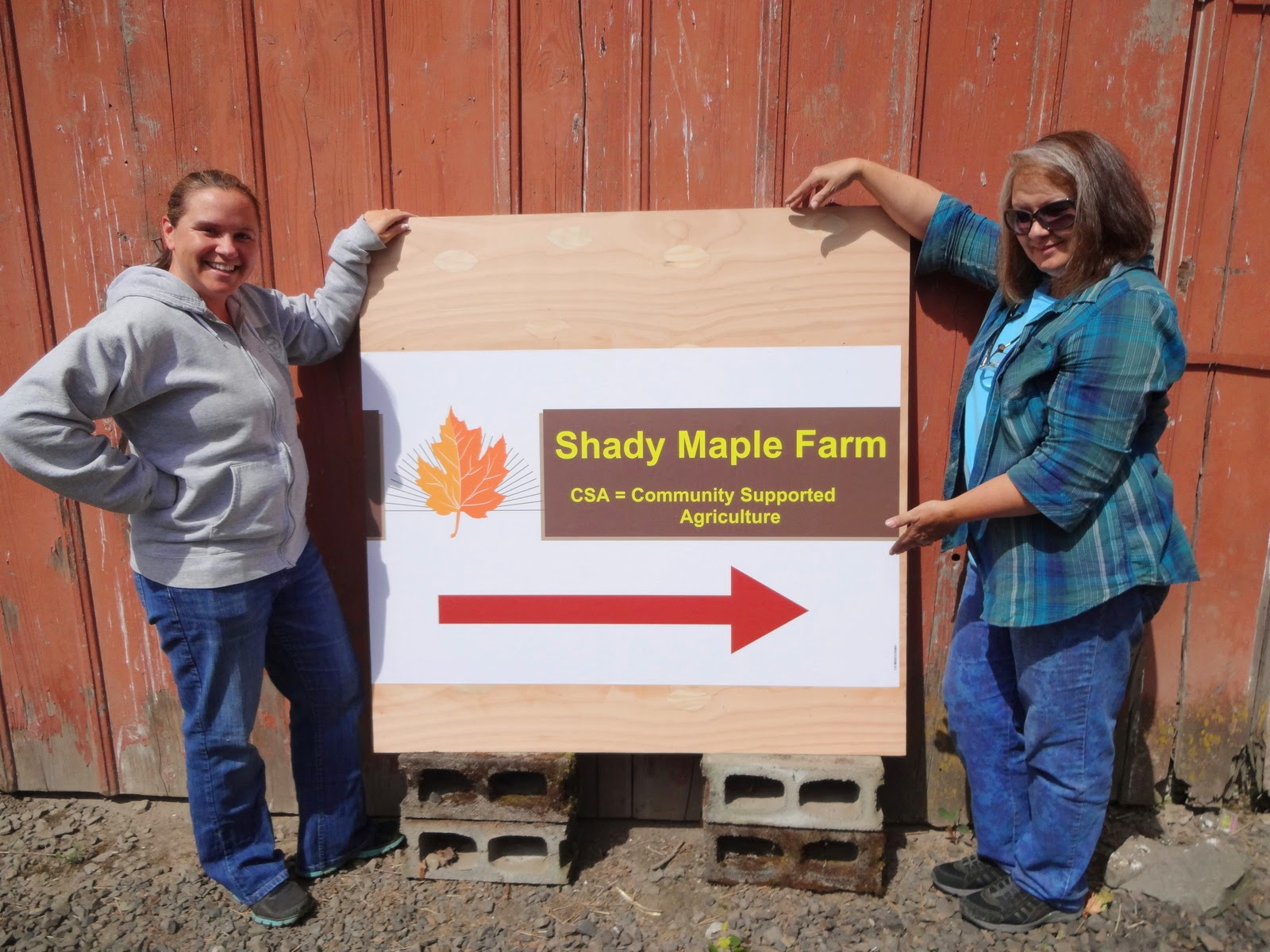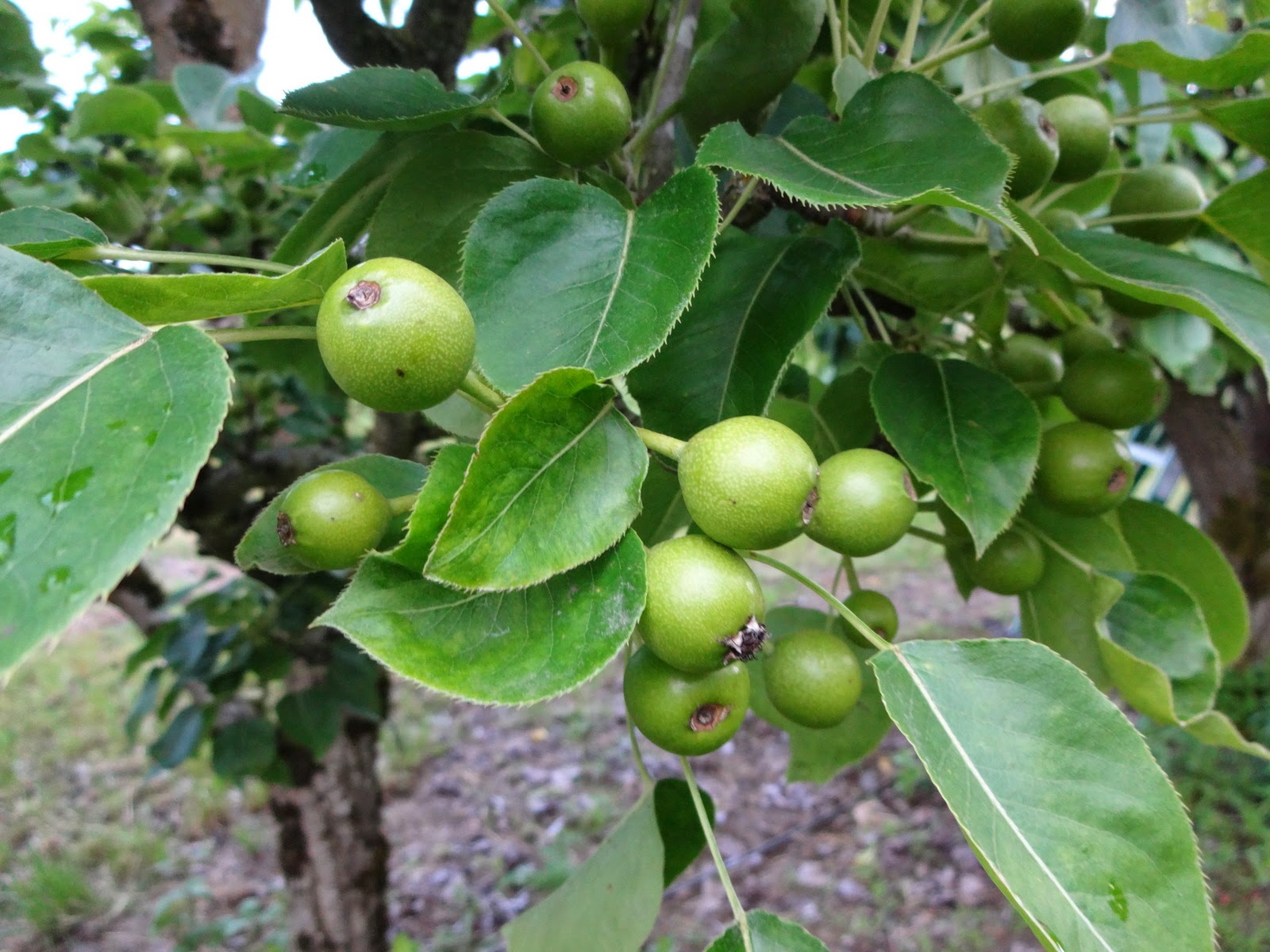 |
| Our new sign. Hopefully by week two it will have a reclaimed barn wood frame from one of the farm buildings. |
 |
| Bill, my grandmother Daisy's niece Faith's best friend pounds in any loose nails on our 1950's harvest boxes before their first use this year. |
 |
| White peonies along with Love Lies Bleeding, an amaranth that we are growing for the first time this year. |
 |
| My nephew's wife Stephanie (niece in law?) and her daughter help pick the yummy strawberries. At this point of the day 3 of my nieces are helping out! |
 |
| I think she is loving this "picking" of berries. A little juice down her chin! |
 |
| Anna's oldest is a very good helper. Here she shows off the purple cauliflower she has helped pick. |
 |
| Anna's middle cherub, picks into his hat of course. |
 |
| Awww, siblings and their cart of broccoli and cauliflower. |
 |
| Bill along with my 4th niece of the day Amber. She just graduated from OSU with a Bachelor of Science degree in Pre-Pharmacy and a minor in Chemistry and will be attending Pharmacy School at OSU in the fall. They are marveling at the colorful Swiss Chard. She probably could tell us why there are so many colors! |
 |
| Yellow chard. |
 |
| Original chard color, white. |
 |
| Magenta chard. |
 |
| Peonies and lupine in one of the bouquets. |
 |
| A single peony along with double peonies and a brighter pink lupine. |
 |
| The greenery in this bouquet is the herb Sweet Sicily. It is mixed with peonies and Love Lies Bleeding. |
 |
| Orange roses with dark blue delphiniums. |
 |
| Pink peonies with lovely verbascum spires. |
 |
| Blue balloon flowers with white peonies and blue salvia. |
 |
| Bill, my grandmother Daisy's niece Faith, and my mother in law, Mary all help even out the selections of colorful Swiss Chard for each harvest box. |
 |
| Angie picks chives, bundles them and puts them into cool water. Her little piggy tailed daughter has been picked up by her grandmother to stay at her house for a nap. This is a family oriented endeavor! |
 |
| Anna finds time to make us a delicious pasta salad. Broccoli, cucumbers, basil and tomatoes from our gardens and greenhouses mixed with kalamata olives, Colby jack cheese and pasta tossed with Italian dressing. Lisa concocted a basil pesto bread. So amazing! They muddled some of today's strawberries and added them to lemonade. Lunch is special here at The Farm. |
 |
| Bill, my mother in law Mary, and my buddy, "other Mary" trim up the lemon grass and organize for the boxes. "Other Mary" and I taught together at Sprague High School for many years. |
 |
| Amber helps pick tea. The newest shoots are harvested. |
 |
| Figs are putting on size in the orchard. |
 |
| Another bouquet, this one with roses in a cluster. |
 |
| This single peony with the long stamens is very showy. One of my favorites. |
 |
| Faith organizes the tags that are attached to our bundles in the warmth of the greenhouse. Of course there is a trike in the greenhouse. :) |
 |
| We tried something new this year, seeding the beets early in the greenhouse and letting them grow there for a month or two before transplanting them into the raised beds. Florencio has transplanted many things this year as we try to improve our springtime selections. Here are red and orange beets. |
 |
| Angie enjoys the red kale. |
 |
| Amber counts the kale stems as Angie cuts them. |
 | ||
What a regular asparagus spear looks like when its growing.
|
 |
| Hmmm. |
 |
| Faith marvels at our unusual find. Can you tell it became rather chilly in the afternoon? |
 |
| Mary, aka, Grams, shows off the radish bunches. |
 |
| "Other Mary" and Bill organize beets so everyone gets 3 red ones and 1 orange one. Even the tops are healthy! |
 |
| Florencio delivers his 3:30 cutting of fresh lettuces. |
 |
| So pretty and delicate. Nothing like fresh lettuce. |
 |
| Today's harvest box contains: radishes, kale, chives, green onions, lemon cucumbers, Swiss Chard, asparagus, lettuce, parsley, beets, tea, strawberries, basil, broccoli or cauliflower and a bouquet of flowers. All of these sitting on a bench our brother Karl fashioned out of the black walnut tree that came down a few years ago by the Potting Shed. |
 |
| My niece Anna, who lives here at The Farm with her husband who is finishing his first year of Veterinary School at OSU, is holding up her youngest little girl and their brand new puppy. All are adorable! |
 |
| Our first bouquet of the year finds a home. |
 |
| Slicing cucumbers enjoy greenhouse life this time of year. |
 |
| Tomatoes bred to produce inside greenhouses tend to grow in clusters. Here is one such cluster. |
 |
| Here is a second large cluster. |
 |
| Red, white, and blue flowers for Memorial Day. I think Dad, who was a WWII veteran, had this planned. |
 |
| 4 rows of tomatoes have been planted through red plastic mulch to increase production and keep the fruit cleaner. Drip irrigation is under the red plastic. Fertilizer is applied through the irrigation system. |
 |
| 4 rows of all varieties of peppers. Also with drip irrigation watering them. |
 |
| 3 rows of watermelon, cantaloupe, honeydew, cucumbers, zucchini, yellow crookneck and patty pan squash enjoy the heat the black plastic encourages. They also have drip irrigation beneath their plastic. |
 |
| The grapes start out very small. Each little green grape was a tiny greenish flower. |
 |
| More grapes on a nearby vine. When they ripen, grapes will be added to the Tuesday boxes. |
 |
| Blueberries seem to be prolific this year. It will take them a couple weeks to fill out and turn blue, then another week or so to sweeten up. Just because a blueberry is blue doesn't mean it is ripe. |
 |
| These are Marionberries. They are emerging from their flowers and growing longer. The whitish parts are sepals and the fuzzy parts are the stamens (male parts). The berry is the female portion. They are also a few weeks away from harvest. |
 |
| This view shows how Florencio has set up the irrigation system. Each year the white pipes are put away and the plastic and drip tape (with drippers built in every 8 inches) are pulled up from the garden after the harvest is finished. New plastic and drip tape is used each year. |
 |
| Sylvanberries will be the first to ripen. At this point it almost looks like they could use a shave! |
t |
| Sylvanberries, one of the many "cane" berries, are biennials. The new canes are down low arching toward the ground, they won't fruit this year. The canes that are "up" on the wires were arching low last year and were put up on the wires last fall. After the "up" canes finish fruiting, they die. Then Florencio trims them to the ground and hauls them to the burn pile. He then puts the young canes up on the wires. These arching ones will bear fruit up on wires next summer. We are always careful not to tromp on next year's canes that will bear next year's fruit. |
 |
| Waldo berries will fruit after the Sylvans. These are also a biennial cane berry. Biennials grow foliage the first year, flower and set fruit the second year and with that their life is "complete" and they die. |
 |
| Several types of radishes are growing in our "reclaimed" ground. Nothing has been planted here for many years. We are hoping that wire worms that plague root crops won't be present. Fingers crossed. |
 |
| Raspberries are changing from flowers to small green berries. |
 |
| These are a small "wild" blackberry that Dad had figured out how to grow here at The Farm. He put pvc pipe over the wires to keep the tender canes from breaking and destroying the fruiting possibilities. |
 |
| Different colored leaves help indicate older canes on raspberries. They are also a biennial and fruit on 2nd year canes. The fall of the first year there will be a small crop at the tips of some raspberry varieties. The main crop comes from fruiting lateral branches in their second summer. |
 |
| An unknown blackberry variety is loaded with maturing fruits. |
 |
| The onions appear to be winning the weed wars. Florencio is being diligent about trying to keep the weeds away from the onions who don't compete with weeds well at all. |
 |
| Chard in the evening light. |
 |
| Annual flowers for the bouquets will be planted in this empty space on this end of the field. |
 |
| Florencio has made these furrows with the tractor. 3 varieties/colors of potatoes will be planted here. |
 |
| Lisa and I went for a walk through the orchard after people picked up their boxes. Apples in the orchard. |
 |
| Pears. |
 |
| A different type of pear. |
 |
| We did spray for apple scab, but these little spots indicate we didn't prevent it all. Lime sulfur is used to prevent apple scab. It is an organic spray. |
 |
| Another pear. Love these colors. |
 |
| A small blemish, probably scab also. It can be peeled off of ripened fruit. |
 |
| Granny Smith apples are the LEAST resistant apple to the apple scab disease. Notice the one in the bottom left. Bummer. |
 |
| Brooks prunes in all their bright green color. They will turn dark purple with a whitish hue that will rub off. Yellow inside. So delicious. |
 |
| Asian pears maturing. |
 |
| Triple Crown blackberries are just starting. They will be huge by fall when they ripen. |
 |
| Looking down the row of Triple Crowns. They are a thornless blackberry. Yippie! |
 |
| A small fruited plum tree that didn't fruit last year. Man is it loaded this year. Lisa and I think it is yellow on the inside and purple on the outside. We don't have any records of which trees are what out in the 98 tree orchard. Dad knew what they all were. |
 |
| Dad loved persimmons. These curly green things are the outside of a persimmon flower. |
 |
| Here is another persimmon flower opened a bit. The fruit is starting to show. They don't ripen until late fall and all the leaves are already off the tree. It will appear to be a bare branched tree with orange decorations, usually in October. |
 |
| The first purple coneflower is opening. |
 |
| Icelandic poppies bloom. |
 |
| Foxglove. |
 |
| Honeysuckle climbs the trellis. |
 |
| A small flowering clematis climbs next to the showy honeysuckle. |




